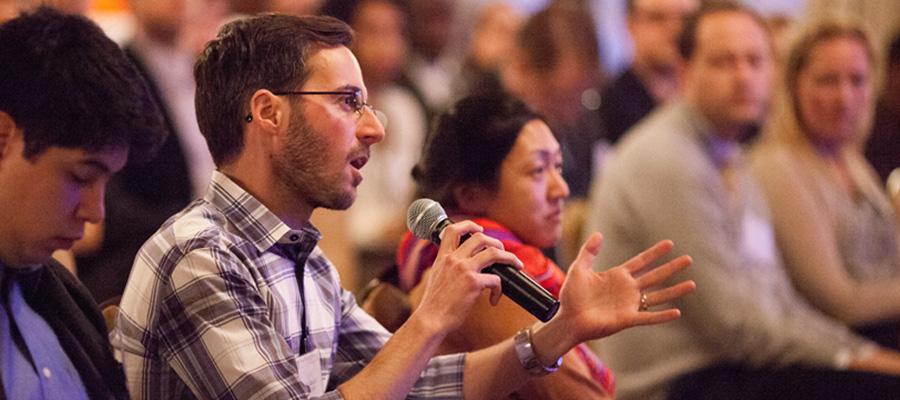The University of Chicago may have sent one of the most bizarre and shady freshmen welcome letters I’ve ever seen, when they mailed the missives to the class of 2020 last week.
The main thrust of the letter isn’t to welcome but to put freshmen on notice that the university doesn’t “condone” safe spaces or trigger warnings. The letter from “Dean Jay,” aka Dean of Students John Jay Ellison, notes that there are university administrators and professors who feel that safe spaces and trigger warnings stifle academic freedom.
“Our commitment to academic freedom means that we do not support so-called ‘trigger warnings,’” said Dean Jay, “we do not cancel invited speakers because their topics might prove controversial, and we do not condone the creation of intellectual ‘safe spaces’ where individuals can retreat from ideas and perspectives at odds with their own. We expect members of our community to be engaged in rigorous debate, discussion, and even disagreement. At times this may challenge you and even cause discomfort.”
There’s a lot of belittling language in here, but I’m going to focus on Dean Jay’s decision to describe racism, sexism, harassment, and violence as “challenging” and a “discomfort” to those who experience it.

This is the featured photo on the University of Chicago’s anti-safe spaces website, freeexpression.uchicago.edu.
Safe spaces started popping up on college campuses in the 1960s as places where LGBTQ students could congregate and talk about their lives without fear of violence or persecution. Eventually, other marginalized groups created safe spaces to discuss the challenges they face.
It’s a blessing to be somewhere — even if it’s just for an hour — where women can talk about rape culture without someone yelling about “Not All Men!” or black people can discuss Black Lives Matter without someone insisting it should be “All Lives Matter.” It’s exhausting to push back against these things all day, every day without a break in sight.
Trigger warnings were born on the internet as a way to alert sexual assault victims that a piece of media was going to handle sensitive material that could “trigger” flashbacks, panic attacks, and memories of that time in their lives. The warnings take less than five seconds to apply to an article or mention before discussing sexual violence. In the U.S., where one in five women are raped at some point in their lives, according to the Sexual Violence Resource Center, a trigger warning is the least society can do — like an extremely lame mea culpa for the hundreds of thousands of untested rape kits sitting in crime labs across the nation.
However, the University of Chicago leaders didn’t make up the safe space/trigger warning controversy; they’re just the first administrators to be condescending weasels about openly dismissing it.
On other campuses, safe spaces and trigger warnings have been used recently to shut down conversation and journalists — two things these tools were not designed to do.
In 2015, for example, a University of Missouri professor as well as students tried to block journalists from covering an on-campus protest about racial discrimination. Protesters and communications professor Melissa Click, who got two degrees from UMass and has since been fired for her anti-press actions, said they were ringed by an impenetrable safe space. But that was false: you can’t kick the public off of a public campus and journalists have a Constitutional right to cover news.
Closer to home, last year Smith College students held a protest in the Campus Center in which organizers required journalists covering the event to pledge allegiance to the protesters’ calls for racial equity. Attempting to force a free press to agree with a group before allowing reporters access to cover an event is horrifying. Journalists should never be beholden to a source.
At some colleges, students have asked trigger warnings to be placed on the classic Greek tragedy Antigone and at Oberlin College professors are asked to put warnings on anything that may trigger readers who have experienced “racism, colonialism, religious persecution, violence, suicide and more.” Of course, for some people, that’s just Tuesday.
There are times when safe spaces and trigger warnings can be wielded to shut down conversation — and this is wrong. But overall, these devises let marginalized people drop their guard, if only for a little while. Administrators at the University of Chicago, and at every other institution of higher education, should allow students to create spaces where they feel safe.
Rather than dismissing the idea, educators should start conversations about what safe spaces are and aren’t; help students understand how to feel comfortable using their voices without fear and create a campus where ideas will be challenged but a person’s life experience will be respected.
It’s the lack of respect for other experiences that makes safe spaces necessary. Though people with the “right” skin, genitalia, sexual desires, and prayers may not have personally felt or noticed the everyday trials of being “different,” it doesn’t mean that these trials aren’t difficult, hurtful, and often destructive — and they’re certainly a hell of a lot more painful than the patronizing “discomfort” mentioned in Dean Jay’s letter.
Whose freedom of expression is being protected by dismantling safe spaces and trigger warnings, anyway? Is it perhaps the people who send out letters like this?
Contact Kristin Palpini at editor@valleyadvocate.com.



